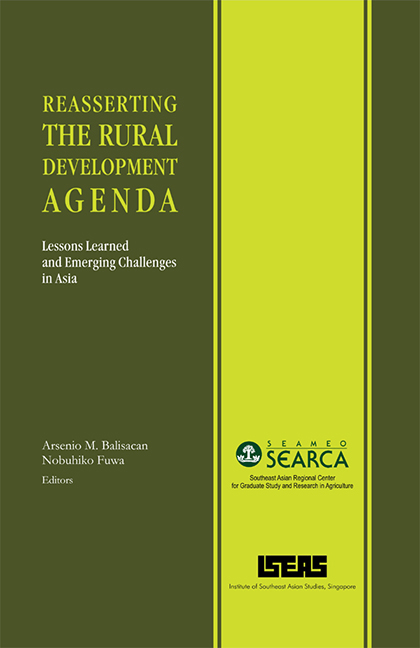Book contents
- Frontmatter
- Contents
- Tables
- Figures
- Preface
- Contributors
- 1 Challenges and Policy Options for Agricultural Development – Overview and Synthesis
- 2 The Economics of Agricultural Development: What Have We Learned?
- 3 The Role of Social Structures and Norms in Agricultural Development: Africa and East Asian Communities Compared
- 4 Food Security in a Globalised Setting
- 5 Poverty and Vulnerability
- 6 Asian Agricultural Development: From the Green Revolution to the Gene Revolution
- 7 Dryland Agriculture in Asia: Ideas, Paradigms, and Policies
- 8 Establishing Efficient Use of Water Resources in Asia
- 9 Improving the Delivery of Extension Services to Rural People: New Perspectives
- 10 Land Tenure and Forest Resource Management in Asia
- 11 Globalisation and the Poverty-Environment Link in Asian Agriculture
- 12 The Supermarket Revolution with Asian Characteristics
- Index
3 - The Role of Social Structures and Norms in Agricultural Development: Africa and East Asian Communities Compared
Published online by Cambridge University Press: 21 October 2015
- Frontmatter
- Contents
- Tables
- Figures
- Preface
- Contributors
- 1 Challenges and Policy Options for Agricultural Development – Overview and Synthesis
- 2 The Economics of Agricultural Development: What Have We Learned?
- 3 The Role of Social Structures and Norms in Agricultural Development: Africa and East Asian Communities Compared
- 4 Food Security in a Globalised Setting
- 5 Poverty and Vulnerability
- 6 Asian Agricultural Development: From the Green Revolution to the Gene Revolution
- 7 Dryland Agriculture in Asia: Ideas, Paradigms, and Policies
- 8 Establishing Efficient Use of Water Resources in Asia
- 9 Improving the Delivery of Extension Services to Rural People: New Perspectives
- 10 Land Tenure and Forest Resource Management in Asia
- 11 Globalisation and the Poverty-Environment Link in Asian Agriculture
- 12 The Supermarket Revolution with Asian Characteristics
- Index
Summary
INTRODUCTION
This chapter aims to shed light on the mechanism of how the social structures of rural communities, such as tribes and villages, fundamentally constrain agricultural development processes, not only through the community members’ individual or collective actions in farm production and investment but, also, through their influences on governments’ actions. Ideally, this task would have required detailed empirical research involving the approaches of sociology and political science to obtain any tangible results. Instead, I attempt in this paper to postulate provisional hypotheses based on my rather casual observations of village communities in both Northeast and Southeast Asia during my numerous field visits there in connection with my other studies. I start this highly exploratory study by comparing community characteristics in East Asia with those in Africa. Because the agricultural and economic growth performances of these two regions sharply contrasted with one another in the past several decades, the comparison is expected to provide some useful insights on identifying which characteristics of communities promote growth and which retard growth.
Indeed, East Asia, particularly Southeast Asia, has been a growth pole of world economy after the Second World War (World Bank 1993). The high economic growth of Japan for two decades beginning in the mid- 1950s was followed by those of Asian NIES such as Korea and Taiwan in the 1960s, and was further reprised in the 1970s by high-performing economies in the Association of Southeast Asian Nations (ASEAN), and in the 1980s by China. In all these cases, the high economic growth was supported by rapid industrialisation based on technology borrowing from more advanced economies, starting with labour-intensive manufacturing and later advancing to more sophisticated knowledge-intensive activities, in a so-called “flying geese” pattern. One of the major factors underlying the success of industrialisation was the high growth performance of agriculture. The rise in the labour-intensive manufacturing of this region was based on the supply of cheap labour, which was critically dependent on the supply of food at low prices. Agricultural innovations, as represented by the “Green Revolution” increased rice output to such an extent as to significantly lower the real price of this critically important wage good for this region during the period 1970–90. This phenomenal performance of agriculture did provide an invaluable support for industrialisation in its initial stage.
- Type
- Chapter
- Information
- Reasserting the Rural Development AgendaLessons Learned and Emerging Challenges in Asia, pp. 63 - 80Publisher: ISEAS–Yusof Ishak InstitutePrint publication year: 2007

